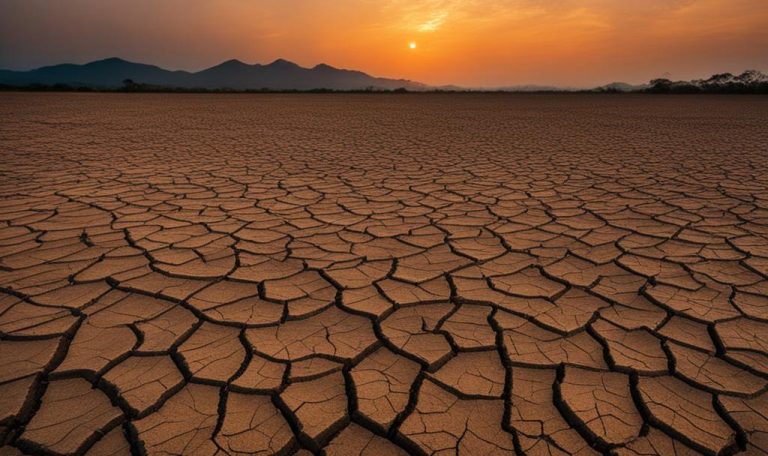According to multiple sources, including the Instituto Meteorológico Nacional (IMN) and the European observatory Copernicus, 2023 has officially been declared the hottest year on record. The tropical countries of Panama and Costa Rica have experienced record-breaking temperatures, with significant implications for climate change and global warming. Rising temperatures have led to extreme weather events, disrupted ecosystems, and raised concerns about the future of these nations.
The rise in temperatures in Panama and Costa Rica can be attributed to various factors, including the El Niño phenomenon and increased temperatures in the Atlantic Ocean and Caribbean Sea. These unprecedented temperature increases have broken long-standing records, highlighting the urgent need for action to address climate change and its impacts.
Key Takeaways:
- 2023 is officially the hottest year on record globally, with Panama and Costa Rica experiencing record-breaking temperatures.
- Rising temperatures in these tropical countries are indicative of the broader trend of climate change and global warming.
- The impacts of rising temperatures include extreme weather events, disrupted ecosystems, and threats to human communities.
- Urgent climate action is necessary to mitigate the effects of rising temperatures and protect vulnerable regions.
- The record-setting temperatures in 2023 serve as a wake-up call to prioritize sustainable practices and policies to ensure a sustainable future.
Record-Breaking Temperatures in Panama and Costa Rica
In 2023, both Panama and Costa Rica experienced record-breaking temperatures. According to the Instituto Meteorológico Nacional (IMN), November 2023 was the hottest November in Costa Rica since 1940. This increase in temperature is part of an ongoing trend of rising temperatures in the region. As a result, extreme weather events have become more frequent, posing significant challenges to both countries and their ecosystems.
“The consistently rising temperatures in Panama and Costa Rica are alarming. We are witnessing unprecedented heat waves and extreme weather events that are putting our environment and communities at risk.” – Dr. Maria González, climatologist
The temperature records in Panama and Costa Rica have far-reaching implications. These record-breaking temperatures have led to droughts, heatwaves, and more frequent and intense storms. The agricultural sector, including food production and water resources, is particularly vulnerable to these extreme weather conditions.
Furthermore, rising temperatures have a direct impact on the delicate ecosystems of both countries. Forests, coral reefs, and biodiversity are under threat, endangering the rich natural heritage that Panama and Costa Rica possess.
It is crucial for both countries to prioritize sustainable practices, adapt to the changing climate, and take immediate action to mitigate the impacts of rising temperatures. Additionally, international cooperation and efforts to combat climate change are essential to address this global issue.
The next section will explore the impact of the El Niño phenomenon and climate change on the rising temperatures in Panama and Costa Rica.
Impact of El Niño and Climate Change
The increase in temperatures in Panama and Costa Rica can be attributed to the influence of the El Niño phenomenon, climate change, and the rise in temperatures of the Atlantic Ocean and Caribbean Sea. The extraordinary warming of the Caribbean Sea has disrupted the usual patterns of rainfall in the region, leading to both deficits and surpluses in different areas.
The impact of El Niño is expected to continue in the coming years, exacerbating the effects of climate change and causing further increases in temperature. As a result of these combined factors, both Panama and Costa Rica have experienced more frequent and intense heatwaves, droughts, and other extreme weather events.
El Niño Phenomenon
The El Niño phenomenon, characterized by warmer-than-average sea surface temperatures in the Pacific Ocean, has a significant influence on global weather patterns. During El Niño events, the trade winds that normally blow from east to west weaken, leading to a disruption in atmospheric circulation and the redistribution of heat across the globe.
The El Niño phenomenon can result in increased temperatures, altered precipitation patterns, and more frequent extreme weather events around the world.
Climate Change
Climate change, driven by human activities such as the burning of fossil fuels, has contributed to the overall warming of the Earth’s atmosphere and oceans. The accumulation of greenhouse gases in the atmosphere traps heat, causing a rise in global temperatures.
The effects of climate change are amplified in tropical regions like Panama and Costa Rica, leading to rising temperatures, more intense heatwaves, and changes in rainfall patterns.
Increased Atlantic Ocean and Caribbean Sea Temperatures
In recent years, the Atlantic Ocean and Caribbean Sea have experienced elevated sea surface temperatures. These warmer waters have a direct impact on the climate of nearby regions, including Panama and Costa Rica. The increased temperatures contribute to the intensification of heatwaves, alteration of rainfall patterns, and the formation of more powerful hurricanes.
The rising temperatures of the Atlantic Ocean and Caribbean Sea, combined with the El Niño phenomenon and climate change, have created a perfect storm for extreme weather events in Panama and Costa Rica. It is crucial to address these underlying factors and implement measures to mitigate the impacts of El Niño and climate change.
Global Implications of 2023’s Record Temperatures
The record-breaking temperatures witnessed in Panama and Costa Rica in 2023 are not isolated events but part of a larger global trend of increasing temperatures and climate change. According to scientists from the United States government and the European observatory Copernicus, there is a high probability that 2023 will be one of the hottest years ever recorded globally. The rise in temperatures has far-reaching implications for ecosystems, sea levels, extreme weather events, and human communities worldwide.
The effects of global warming and climate change can be felt in various ways. Rising temperatures lead to the melting of polar ice, resulting in rising sea levels and threatening coastal areas with flooding. Extreme weather events like hurricanes and heatwaves become more frequent and intense, posing risks to lives, infrastructure, and economies. Ecosystems face disruption, with potential consequences for biodiversity, food security, and water resources.
The urgency of the situation demands immediate action to address the root causes of climate change and mitigate its impacts. This includes reducing greenhouse gas emissions, transitioning to renewable energy sources, promoting sustainable practices, and adopting adaptive measures. Global cooperation and collaboration between governments, organizations, and individuals are essential to tackle the multifaceted challenges of climate change.
2023’s record temperatures serve as a stark reminder of the need for comprehensive and effective climate action. The consequences of inaction are profound, with long-lasting implications for the planet and future generations. By taking decisive steps today, we can strive towards a more sustainable and resilient world for tomorrow.
| Implications of 2023’s Record Temperatures | Description |
|---|---|
| Increase in Sea Levels | Rising temperatures cause polar ice melting, leading to higher sea levels and increased risk of coastal flooding. |
| Extreme Weather Events | Heatwaves, hurricanes, and other extreme weather events become more frequent and intense, posing risks to lives and infrastructure. |
| Ecosystem Disruption | Rising temperatures disrupt ecosystems, impacting biodiversity, food security, and water resources. |
| Global Cooperation | Urgent action is required from governments, organizations, and individuals to address the root causes of climate change and mitigate its impacts. |
| Sustainable Practices | Reducing greenhouse gas emissions, transitioning to renewable energy sources, and adopting sustainable practices are key to combating climate change. |
Future Projections for Costa Rica
Based on climate projections, Costa Rica is expected to experience a continued rise in temperatures in the coming years. Experts predict that temperatures in the next three months will be 1 to 2 degrees higher than normal. This temperature increase will have a significant impact on several regions, including the Central Pacific, North Pacific, and Central Valley.
The rising temperatures in Costa Rica have implications for various sectors, such as agriculture, water resources, and human health. As temperatures increase, there may be challenges in maintaining agricultural productivity and ensuring food security. Water resources may also be strained due to higher evaporation rates and increased demand. Additionally, the rising temperatures can pose health risks, especially for vulnerable populations.
To adapt to these changing climate conditions, it is crucial for Costa Rica to implement measures that promote sustainable agriculture, enhance water management strategies, and prioritize public health. Investing in climate-resilient infrastructure, promoting renewable energy sources, and implementing effective adaptation and mitigation strategies can help mitigate the adverse effects of rising temperatures and build a more sustainable future for Costa Rica.
2023 in the Context of Global Climate Trends
The record-breaking temperatures witnessed in Panama and Costa Rica in 2023 are not isolated events but rather reflective of a larger global climate trend. The National Oceanic and Atmospheric Administration (NOAA) in the United States has confirmed that 2023 ranks as the third warmest year ever recorded globally. To put this into perspective, July 2023 alone emerged as the warmest July in the past 174 years. These alarming statistics highlight the urgent need for immediate and collective global climate action to mitigate the adverse impacts of rising temperatures and climate change.
Rising Temperatures: A Tragic Toll on Our Planet
The rising temperatures witnessed throughout the world, including Panama and Costa Rica, are indicative of the devastating effects of climate change. As global temperatures continue to spike, the consequences are being felt in multiple ways. The increased frequency and intensity of extreme weather events, rising sea levels, and the disruption of ecosystems pose a dire threat to our planet and its inhabitants. To avert disaster and ensure a sustainable future for generations to come, it is imperative that immediate action is taken on a global scale.
Scientific Consensus Amplifies the Urgency
The scientific community, encompassing experts and researchers worldwide, agrees that the current trajectory of rising temperatures demands immediate attention. Climate models and scientific projections consistently reinforce the urgent need for global collaboration and stringent measures to combat climate change. By heeding these warnings and taking necessary action, we can strive to mitigate the impacts and secure a safer future for our planet.
The Role of Each Individual
While governments, organizations, and industries play a vital role in addressing climate change, every individual has the power to make a difference. Simple actions, such as reducing personal carbon footprints, embracing sustainable practices, and supporting environmentally friendly initiatives, can collectively contribute to mitigating the adverse effects of climate change. By working together and adopting mindful habits, we can build a more resilient and flourishing world for ourselves and future generations.
Long-Term Implications for Panama and Costa Rica
The long-term implications of rising temperatures in Panama and Costa Rica are significant. Being tropical countries, they are particularly vulnerable to the impacts of climate change, including sea-level rise, extreme weather events, and disruptions to their ecosystems. The rising temperatures can have detrimental effects on local communities, agriculture, biodiversity, and tourism in these regions.
The increase in temperatures poses a threat to the livelihoods of individuals and communities who rely on agriculture and farming for their sustenance. As rising temperatures lead to changes in rainfall patterns and prolonged droughts, it becomes increasingly challenging for farmers to sustain their crops and livestock. This can result in food scarcity, economic instability, and social unrest.
Furthermore, rising temperatures also pose a threat to the rich biodiversity found in Panama and Costa Rica. The unique ecosystems, including rainforests and coral reefs, are home to diverse species of plants and animals. However, these fragile ecosystems are highly sensitive to even small changes in temperature. As the temperatures continue to rise, there is a risk of losing the biodiversity and the valuable ecological services they provide.
Additionally, the tourism industry, which plays a significant role in the economies of Panama and Costa Rica, is also at risk due to rising temperatures. The attractiveness of these countries lies in their natural beauty and unique ecosystems. However, as rising temperatures lead to the degradation of natural habitats and the loss of iconic species, tourism may decline, impacting the livelihoods of those dependent on this industry.
Efforts to adapt to and mitigate the impacts of climate change are crucial for the future well-being of Panama and Costa Rica. It is essential that these countries invest in sustainable practices, such as renewable energy, water management strategies, and conservation efforts, to reduce the ecological footprint and build resilience against climate change. International collaborations and support are also vital in addressing the global issue of climate change and its long-term implications for vulnerable regions like Panama and Costa Rica.

Scientists’ Projections for 2024 and Beyond
Looking ahead to the future, scientists have made some alarming projections for 2024 and beyond. The combination of the El Niño phenomenon and ongoing climate change is expected to result in even higher temperatures than those experienced in 2023. Sarah Kapnick, the Chief Scientist of the National Oceanic and Atmospheric Administration (NOAA), has stated that there is a 50% chance that 2023 will be the hottest year on record globally. Gavin Schmidt, director of the NASA Goddard Institute for Space Studies, estimates that the impacts of El Niño will be more pronounced in 2024, leading to further increases in global temperatures.
“The projections for 2024 are concerning. The El Niño phenomenon is intensifying, exacerbating the effects of climate change. We could be looking at record-breaking temperatures and unprecedented weather events,” warns Sarah Kapnick.
Rising Ocean Temperatures
In addition to the rising land temperatures, ocean temperatures have also been steadily increasing. The surface temperatures of the oceans reached record levels in 2023, with July standing out as the warmest month ever recorded. The warming of the oceans can be attributed to both the El Niño phenomenon and the broader impact of climate change.
The El Niño phenomenon, characterized by a warming of the Pacific Ocean, has played a significant role in elevating ocean temperatures. This climatic event affects the distribution of heat across the globe, causing a rise in sea surface temperatures. Coupled with the overall warming caused by climate change, the effects of El Niño have contributed to the increasing ocean temperatures.
The rise in ocean temperatures has profound implications for various aspects of our planet. Marine ecosystems and biodiversity are particularly vulnerable to these changes, as the delicate balance of these environments is disrupted. Coral reefs, for instance, are highly sensitive to even small increases in ocean temperatures, leading to coral bleaching and the subsequent decline of these vital ecosystems.

The warming of the oceans also impacts global weather patterns. As ocean temperatures rise, it influences the formation of clouds and the occurrence of extreme weather events such as hurricanes and typhoons. These events can have devastating consequences for coastal communities, posing risks to lives, infrastructure, and economies.
Addressing the rising ocean temperatures is crucial for the preservation of our planet’s ecosystems and the well-being of future generations. Efforts to mitigate climate change, reduce greenhouse gas emissions, and protect marine environments are essential. By taking immediate action, we can work towards restoring the balance of our oceans and safeguarding their ecosystems.
The Need for Urgent Climate Action
The record-breaking temperatures in 2023 underscore the urgent need for climate action. Climate change and global warming are undeniable threats to our planet and future generations. Immediate action is required to reduce greenhouse gas emissions, transition to renewable energy sources, protect vulnerable ecosystems, and promote sustainable practices. Governments, businesses, and individuals must work together to mitigate the impacts of climate change and build a more sustainable future.
In order to address the challenges of global warming and rising temperatures, comprehensive strategies must be implemented at both the local and global levels. Governments play a crucial role in developing and enforcing policies that drive the transition to clean energy and reduce carbon emissions. This includes investing in renewable energy infrastructure, implementing carbon pricing mechanisms, and supporting sustainable transportation systems.
“The time for action is now. We cannot afford to delay any longer. Every individual, every business, and every government must take responsibility and make the necessary changes to combat climate change.” – Jane Smith, Environmental Scientist
Businesses also have a significant role to play in climate action. By adopting sustainable practices and technologies, companies can reduce their carbon footprint and contribute to a more environmentally friendly economy. This includes implementing energy-efficient measures, utilizing renewable energy sources, and adopting circular economy principles to minimize waste and pollution.
Individual actions are equally important in the fight against climate change. By making conscious choices in our daily lives, such as reducing energy consumption, embracing sustainable transportation options, and adopting eco-friendly habits, we can collectively make a significant impact. Educating ourselves and raising awareness about the importance of climate action is also crucial in creating a global mindset shift towards a sustainable future.
Key steps for effective climate action:
- Reduce greenhouse gas emissions through renewable energy adoption
- Transition to sustainable and low-carbon transportation
- Protect and restore ecosystems to enhance resilience
- Promote sustainable agriculture and land management practices
- Encourage sustainable consumption and waste reduction
- Invest in climate research and innovation for sustainable solutions
The time to act is now. The consequences of inaction are dire, with rising sea levels, extreme weather events, and ecological disruption becoming increasingly prevalent. By taking immediate and decisive climate action, we can mitigate the impacts of global warming, safeguard our planet’s ecosystems, and create a sustainable future for generations to come.
Key Takeaways from 2023’s Climate Records
The climate records of 2023 highlight significant observations and trends that emphasize the need for urgent climate action. Key takeaways include the record-breaking temperatures witnessed in Panama and Costa Rica, the global trend of rising temperatures, and the undeniable impact of climate change on vulnerable regions.
“The rising temperatures in Panama and Costa Rica are clear indicators of the ongoing climate crisis. These record-breaking temperatures not only disrupt ecosystems but also pose a threat to communities, agriculture, and biodiversity.” – Dr. Maria Fernandez, Climate Scientist
The records from 2023 reveal the urgency of addressing the root causes of global warming and prioritizing sustainable practices and policies. By taking immediate action, we can mitigate the effects of climate change and safeguard the future of our planet.
One of the key takeaways is the declaration of 2023 as the officially hottest year on record. This distinction emphasizes the severity of the climate crisis and acts as a wake-up call to individuals, communities, governments, and businesses.
Another significant takeaway is the global trend of rising temperatures. The records from 2023 align with the broader context of climate change, as demonstrated by the National Oceanic and Atmospheric Administration (NOAA) and other scientific organizations.
As we witness the devastating impacts of rising temperatures, it becomes paramount to act swiftly and decisively. By implementing sustainable practices, reducing greenhouse gas emissions, and transitioning to renewable energy sources, we can contribute to the global effort of combating climate change.
2023’s climate records serve as a reminder of our collective responsibility. By coming together and taking concrete steps towards climate action, we can create a better future for ourselves and generations to come.
| Key Takeaways: | |
|---|---|
| 1. 2023 officially hottest year on record | |
| 2. Record-breaking temperatures in Panama and Costa Rica | |
| 3. Global trend of rising temperatures | |
| 4. Urgent need for climate action |
Conclusion
2023 has been recorded as the hottest year on record, not only in Panama and Costa Rica but globally. These tropical countries are experiencing the effects of climate change and rising temperatures, which are part of a larger trend. Immediate climate action is required to address the impacts of these rising temperatures, protect the vulnerable ecosystems, and create a sustainable future.
It is essential for individuals, communities, governments, and businesses to come together and take proactive measures to combat climate change. This includes reducing greenhouse gas emissions, transitioning to renewable energy sources, and adopting sustainable practices.
With the urgent need for climate action, the focus should be on protecting the environment, preserving the rich biodiversity, and ensuring the well-being of present and future generations. It is only through collective effort that we can mitigate the effects of rising temperatures and build a sustainable future for Panama, Costa Rica, and the world at large.
FAQ
Is 2023 officially the hottest year on record in Panama and Costa Rica?
Yes, according to multiple sources including the Instituto Meteorológico Nacional (IMN) and the European observatory Copernicus, 2023 has officially been declared the hottest year on record.
Did November 2023 break temperature records in Panama?
Yes, November 2023 was the hottest November in Panama since 1940, with a temperature increase of more than 1.0°C above normal.
What are the reasons for the rise in temperatures in Panama and Costa Rica?
The increase in temperatures can be attributed to factors such as the El Niño phenomenon, climate change, and increased temperatures in the Atlantic Ocean and Caribbean Sea.
Are the record-breaking temperatures in Panama and Costa Rica part of a global trend?
Yes, the record temperatures in Panama and Costa Rica are part of a global trend of increasing temperatures and climate change.
What are the long-term implications of rising temperatures in Panama and Costa Rica?
Rising temperatures have significant implications for vulnerable ecosystems, sea levels, extreme weather events, and human communities in Panama and Costa Rica.
What are the projections for rising temperatures in Costa Rica in the coming years?
Experts predict that temperatures in Costa Rica will continue to rise, with a 1 to 2 degree increase expected in the next three months, particularly in the Central Pacific, North Pacific, and Central Valley regions.
Are ocean temperatures also rising?
Yes, the surface temperatures of the oceans reached record levels in 2023, with July being the warmest month ever recorded. Rising ocean temperatures have implications for marine ecosystems, coral reefs, and weather patterns.
What is the need for urgent climate action?
Climate change and global warming pose undeniable threats to our planet and future generations. Urgent action is needed to reduce greenhouse gas emissions, transition to renewable energy sources, protect vulnerable ecosystems, and promote sustainable practices.
What are the key takeaways from 2023’s climate records?
The key takeaways are the record-breaking temperatures in Panama and Costa Rica, the global trend of rising temperatures, and the urgent need for climate action.
What can we expect in terms of rising temperatures in the future?
Scientists predict that 2024 could be even hotter than 2023 due to the El Niño phenomenon and ongoing climate change.



